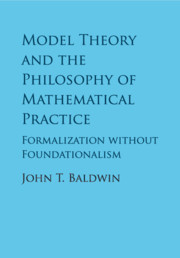Book contents
- Frontmatter
- Dedication
- Contents
- List of Figures
- Acknowledgments
- Introduction
- PART I REFINING THE NOTION OF CATEGORICITY
- PART II THE PARADIGM SHIFT
- PART III GEOMETRY
- PART IV METHODOLOGY
- 12 Formalization and Purity in Geometry
- 13 On the Nature of Definition: Model Theory
- 14 Formalism-Freeness (Mathematical Properties)
- 15 Summation
- References
- Index
13 - On the Nature of Definition: Model Theory
from PART IV - METHODOLOGY
Published online by Cambridge University Press: 19 January 2018
- Frontmatter
- Dedication
- Contents
- List of Figures
- Acknowledgments
- Introduction
- PART I REFINING THE NOTION OF CATEGORICITY
- PART II THE PARADIGM SHIFT
- PART III GEOMETRY
- PART IV METHODOLOGY
- 12 Formalization and Purity in Geometry
- 13 On the Nature of Definition: Model Theory
- 14 Formalism-Freeness (Mathematical Properties)
- 15 Summation
- References
- Index
Summary
As promised in the introduction, we now consider the following goal of Maddy, in the light of classification theory.
In sum, then, the Second Philosopher sees fit to adjudicate the methodological questions of mathematics – what makes for a good definition, an acceptable axiom, a dependable proof technique – by assessing the effectiveness of the method at issue as means towards the goal of the particular stretch of mathematics involved. ([Maddy 2007], 359)
We focus on how to make useful definitions. That is, we study, not the role of formal definition, but the strategy for making informal definitions in mathematics and particulary in model theory. We analyze the motivation for the dividing line strategy.
For context, we consider some earlier work on the justification of definitions. In [Tappendon 2008a, Tappendon 2008b], Tappenden argues for the necessity of studying the notion of definition in context, asserting ‘the math matters.’ In explaining how the actual mathematics matters, he proposes that ‘fruitfulness’ and ‘naturality’ (‘possesses a certain kind of appropriateness or correctness’) are markers of ‘good’ definitions. We expand below on the meaning of ‘appropriate and correct’ in our context. But first we emphasize the point of one of Tappenden's examples: the role of the Legendre symbol. With this symbol, the law of quadratic reciprocity, which is complicated to state because of many cases, becomes a single equation. But, Tappenden argues, this ease of statement is not the reason for its significance; rather the symbol simplified proofs and was a tool for the eventual solution of Hilbert's 9th problem. The crucial point for us is that while a specific technical definition (Legendre symbol) might be a focus at one stage, the significance of the definition is investigated in the context of its role in a wider theory (algebraic number theory).
Similarly, Lakatos emphasizes variations of proof-centered definition. His guiding illustration is the development of the concept of a polyhedron. Lakatos expounds, in his Socratic exploration, the attempt to verify Euler's assertion that for any ‘polyhedron’ with E edges, V vertices, and F faces, E=V +F−2. He shows how the interpretation of these variables changed in the 2,000-year passage from the Greek picture of a polyhedron to chains of simplices and the notion of Euler characteristic in topology. The test of a definition is how it performs in proving the result.
Information
- Type
- Chapter
- Information
- Model Theory and the Philosophy of Mathematical PracticeFormalization without Foundationalism, pp. 283 - 299Publisher: Cambridge University PressPrint publication year: 2018
